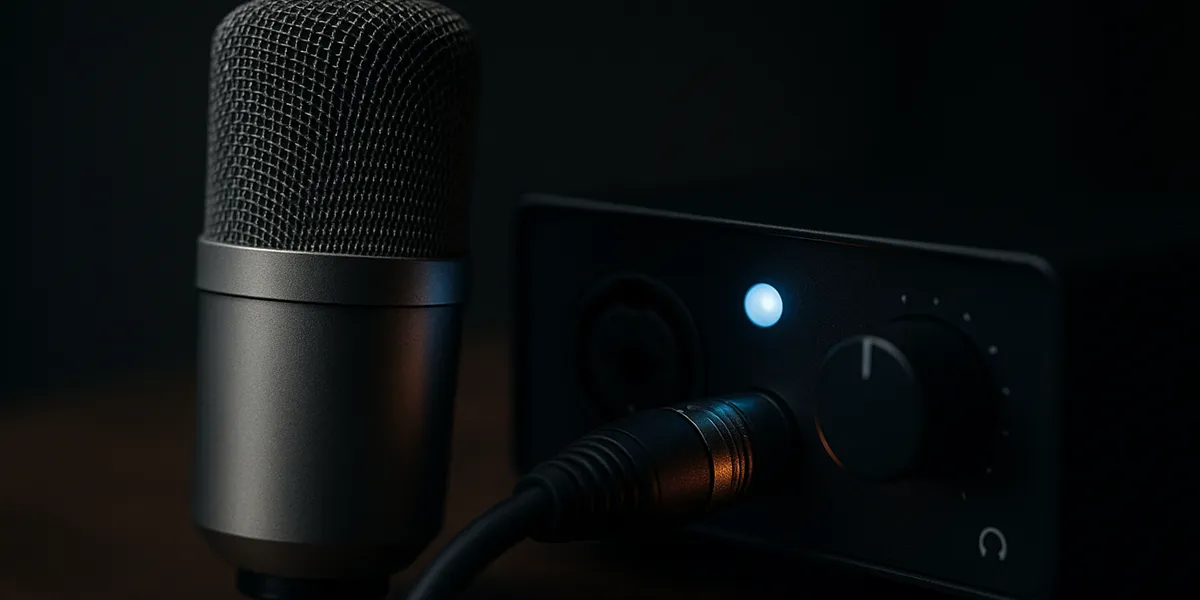Aokeo
Newsletter
Receive access to products and news.
Will be used in accordance with our Privacy Policy
Receive access to products and news.
Will be used in accordance with our Privacy Policy

Maybe you've heard people talk about "phantom power" when discussing mics and sound gear. Phantom power is needed for some microphones (like condenser mics) to operate. This article will give you a detailed explanation of this subject.
Special microphones (like condenser types) have parts that need electricity. For music and talking, we use phantom power to give them electricity.
Phantom power is a little spark (48 volts) traveling through mic cables. It comes from your computer sound box or mixer. It uses the same special cable that catches your voice. Your voice stays clear and doesn't change. Two wires carry the electricity through this cable. The third wire is just the ground.
Aokeo Phantom+XLR Phantom Power Supply delivers studio-grade 48V phantom power to fuel any condenser microphone, ensuring pristine audio capture for vocals, instruments, and podcasting. Perfect for home studios, field recordings, or professional setups.
Some microphones (condenser types) have parts that work like tiny electricity holders. When sound touches their inside layer, it changes into electric messages. These parts need power to work correctly.
Phantom power gives electricity to these microphone parts so they can do their job.
No phantom power means these special parts can't operate. No working parts means the microphone can't change your voice/sound into electric messages. That's the main job of condenser microphones.
Also, some fancier mics have extra stuff like small screens or lights. Those extra things need phantom power too!
When playing with sound tools, you'll often see "P48" or "48V" written on big sound boxes. The most common devices that give phantom power are:
These boxes push the magic electricity (phantom power)
How to turn it ON:
Remember: Always plug in your mic first before pushing magic power buttons!
Aokeo Wireless Microphone System
Aokeo V200 Wireless Microphone System includes two durable metal handheld mics with a 100ft range. Perfect for singing, speeches, teaching, karaoke, church, and DJs. Designed for external devices with a 6.35mm interface, it ensures clear, cordless performance. Comes with a protective case for easy storage and transport.
Aokeo V400 Wireless Microphone system
The Aokeo 4-Channel UHF Wireless Microphone System includes four handheld dynamic mics and a sturdy metal receiver. Ideal for karaoke, singing, weddings, parties, speeches, and church events, it delivers clear, stable sound with reliable wireless performance. Perfect for multiple users, ensuring seamless audio for any occasion.
Active = "Needs batteries/electricity"
Not active (passive) = "Works by itself"
|
Mic Type |
Needs Phantom? |
|---|---|
|
Normal Dynamic Mic |
❌ No |
|
"Active" Dynamic Mic |
✔️ Yes (for extras!) |
|
Ribbon Mic |
❌ No ⚠️ (Danger with phantom!) |
|
USB Mic |
❌ No (Gets USB "snacks") |
|
Tube Mic |
❌ No (Uses special power box) |
Answer: Yes, but it’s rare. Most new mics are totally safe!
Modern supersensitive mics (condensers) and regular mics (dynamics) actually need phantom power to work right. (check more about condenser vs dynamic mic)But treat certain older microphones, like the very delicate "beautiful silk" types (ribbon mics), with care – never turn on phantom power with these, or you could break them!
One important rule works for all microphones: Always turn OFF your phantom power before unplugging or changing mics.
Why? If you leave it on, your ears might get hurt by a sudden, loud POP! sound, and over time, your gear could slowly get damaged.
Quick Safety Table
|
Mic Type |
Phantom Power Okay? |
|---|---|
|
Regular Dynamic Mic |
✔️ YES (Safe) |
|
Supersensitive Mic |
✔️ YES (Safe) |
|
Beautiful Ribbon Mic |
❌ NO! ⚠️ |
|
USB Mic |
✔️ YES (Safe) |
While microphones are the most common users, phantom power isn't exclusively for them.
Certain other audio devices, specifically "active" ones that contain electronic components, also require this power to operate. Good examples include inline signal boosters and DI (Direct Injection) boxes, often used when recording instruments.
Conversely, most other musical instruments or XLR-connected equipment typically do not need phantom power.
Phantom power started long ago to power old telephones. Later, the 48-volt (48V) version became popular for music gear.
Here’s why 48V became the standard:
Back in 1966, a radio company in Norway (NRK) asked a company named Neumann for new microphones. They wanted these mics to get power through their cables, not from a separate power box.
Luckily, their studios already had 48V electricity in the walls for safety lights. So they used that same 48V power for the microphones. This idea became an official rule and stayed that way.
Why "Phantom"?
Before this, special mics (condenser mics) needed big separate power boxes. With phantom power, the electricity comes invisibly through the mic cable. Since you don’t see the power source, people called it "phantom" – like a hidden ghost!
This ends our talk about phantom power! I hope you now know what it is and how people use it when working with microphones.
If you still have questions or want to talk more about this, please reach out. You can email us or send a message on our social media page.
No account yet?
Create an AccountGet notified about Aokeo products, news, and events.